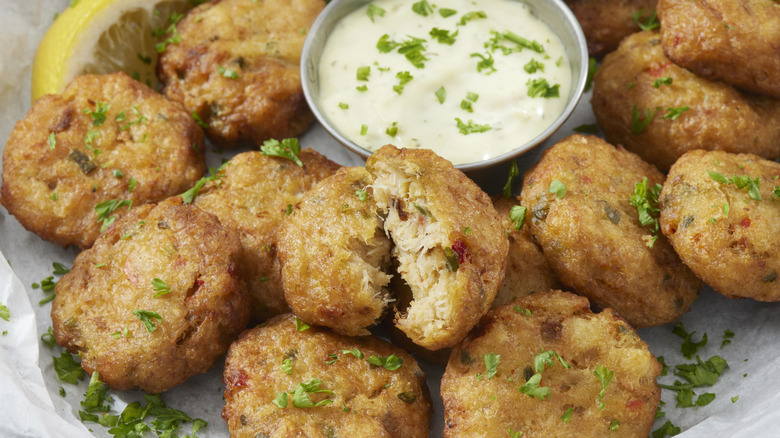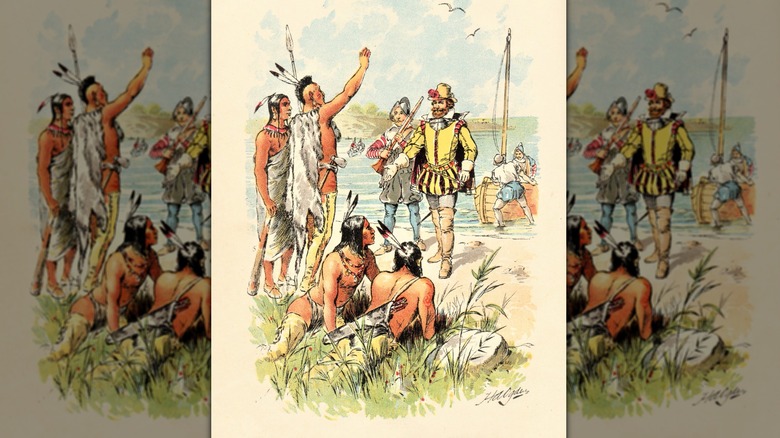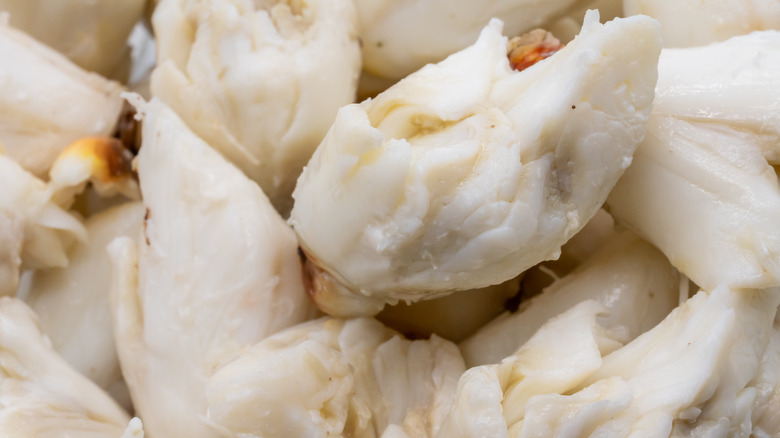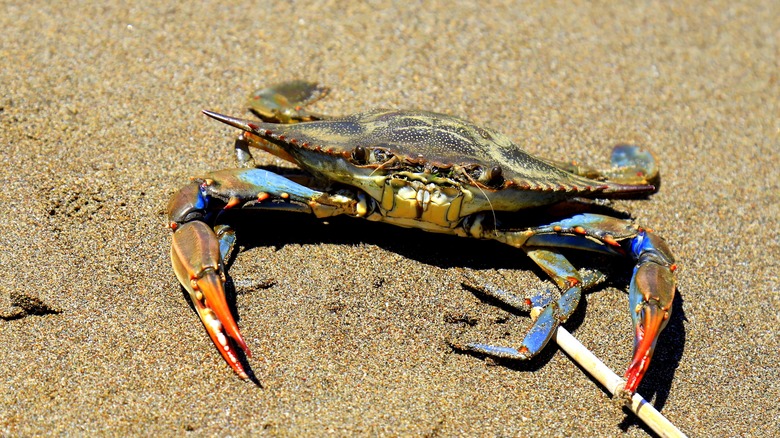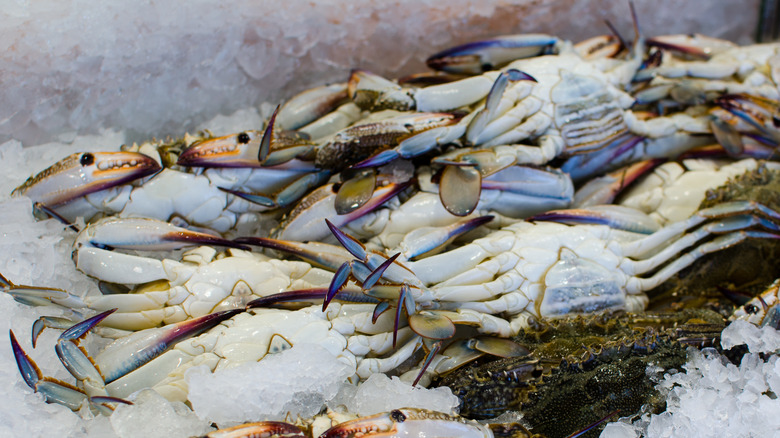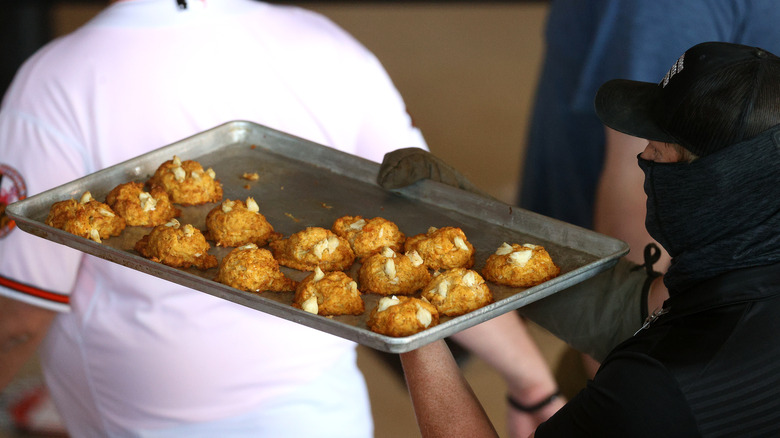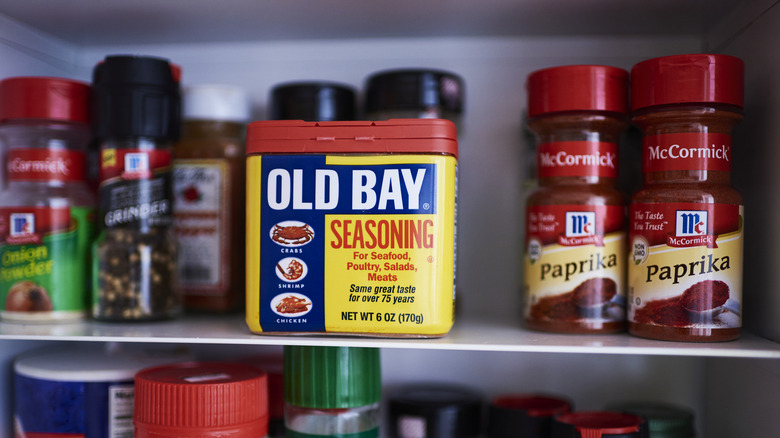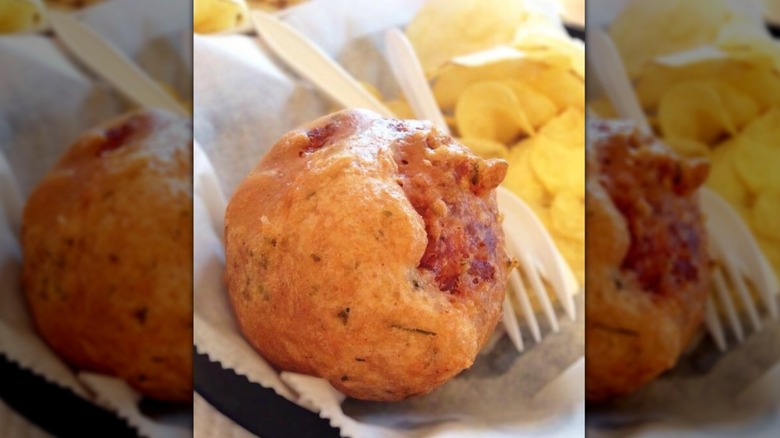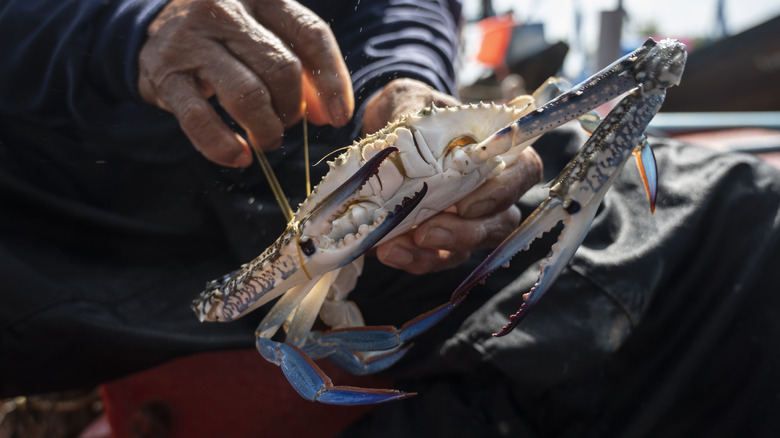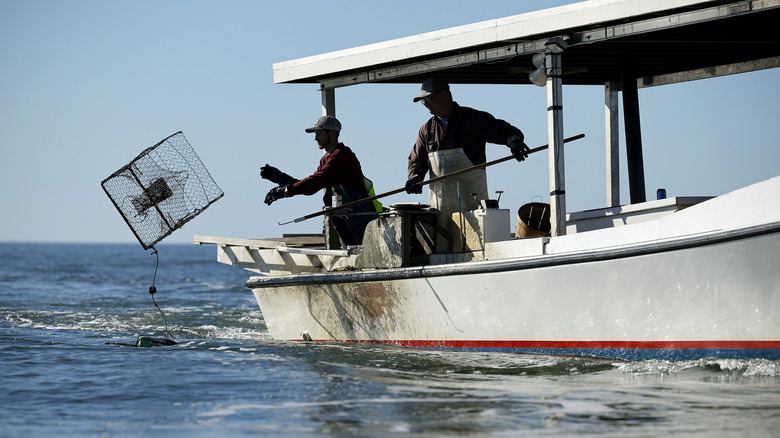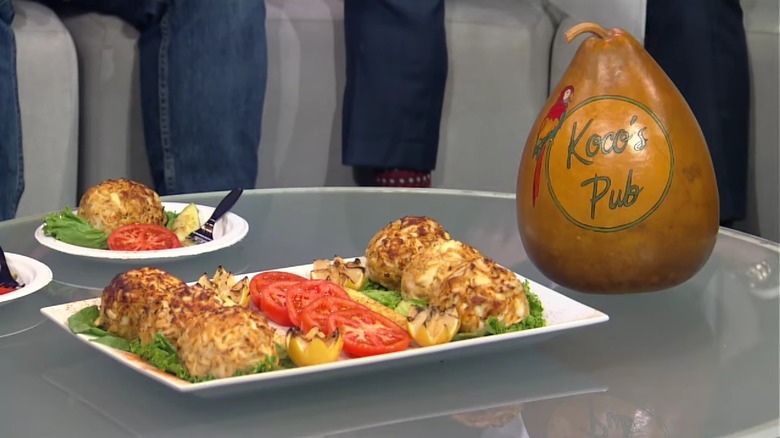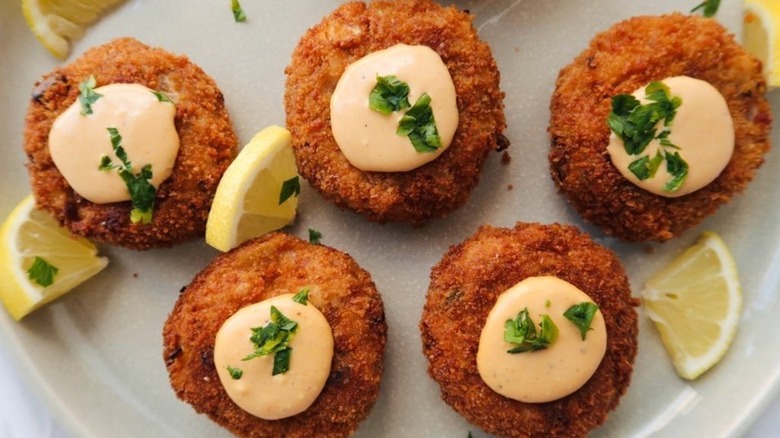Everything We Know About The History Of Crab Cakes
Crab cakes are a classic American appetizer that's served in restaurants and homes across the country. Deceptively simple, the dish is made by mixing pieces of crab meat with associated fillers such as breadcrumbs, binding agents like egg yolks, and seasonings to form a patty. These patties can be cooked in several different ways, although baking and frying are the most popular.
The simple nature of crab cakes belie their long and complicated history. Debates concerning the dish's origins abound as do discussions about more modern practices including the use of imported crab meat. Further issues, such as how the production of crab cakes might be affected by climate change, are also a part of the dish's developing history. All of these matters are examined in the following article as we delve into everything we know about the history of crab cakes. Who knows, after reading, you might not think crab cakes are so simple after all.
Indigenous Americans may have invented crab cakes
The origin of crab cakes is contested. Most people hold one of two viewpoints. The first is that crab cakes were invented by the Indigenous tribes that lived on America's coastlines prior to the land mass colonization. The second viewpoint contends that crab cakes were brought to the United States by the colonists themselves.
There is no doubt that crabs were a major food source for Indigenous Americans. Near the Chesapeake Bay, archaeological sites prove that Indigenous people were eating the crustaceans over 3,000 years ago. Given the abundance of crabs in the area, it is reasonable to suggest that they did so with regularity and invented several crab-based dishes as a consequence. Some people believe that crab cakes were one of these dishes and have suggested that Indigenous people formed patties by combining picked crab meat with cornmeal before cooking them in bear fat. It is hypothesized that colonists adopted the crab cake at a later date.
The other argument suggests that American crab cakes were invented by European colonists and enslaved Africans using culinary practices from their own countries. This theory is supported by the fact that both European and African peoples have a long history of making fritters, patties, and cakes.
Written crab cake references appeared in the 19th century
Written references to dishes that resemble modern crab cakes started appearing during the 19th century. Among these is a crab cake recipe that was featured in Thomas Jefferson Murrey's "Cookery with a Chafing Dish," a cookbook published in 1891. Murrey's recipe is simple, calling for meat from boiled, hard-shelled crabs to be mixed with an egg yolk. The cake was seasoned with salt and pepper before being fried.
Other earlier references mention crab cutlets and crab patties which some historians believe to be other names for crab cakes. Among these references is a crab cutlet recipe published in a Scottish cookbook, "The Practice of Cookery and Pastry." A mention of crab patties is also found in "Lady Nugent's Journal," which Lady Nugent wrote during her time in Jamaica between 1801 and 1805. Both mentions suggest that crab cakes were not uncommon during the 19th century, even though many "early recipes" were only published the following century.
During the 20th century, crab meat was classified
As crab cakes became an even more popular food during the 20th century, terms used to describe the meat were adopted. In his 1905 book, "The Crab Industry of Maryland," Winthrop A. Roberts classified three different types of crab meat: flakes, ordinary, and fat. At this point in time, flakes were deemed the most desirable.
The classification of, and preferences for, crab meat has since changed. Today, the meat is usually placed into one of four groups: claw meat, backfin, lump, and jumbo lump. In terms of crab cakes, the most desirable of these used to be backfin, which is made from an amalgamation of small flakes. However, jumbo lump — large pieces of meat that come from the blue crab's swimming legs — became more popular during the 1990s. Jumbo lump is now seen as the best option for crab cakes, although those seeking an intense taste should opt for the sweet and flavorful claw meat.
Blue crab was, and is, preferred
Blue crabs (Callinectes sapidus) are the species native to Chesapeake Bay and have become the gold standard for American crab cakes. This is not due to tradition but taste. The meat of this species is prized for its briny, buttery, and sweet flavor. Although blue crabs can be found along the coast of both North and South America, the taste of the Chesapeake Bay blue crab is distinct, for reasons chef Spike Gjerde highlighted to Eater: "[Chesapeake Bay] Blue crab is really unlike any other crab in the world, thanks to the growing conditions, and the type of estuary we have here. They are superior to any other crab in my opinion."
In the northwest, Dungeness crabs, hailing from the waters surrounding Alaska, are often used to make crab cakes. The meat of Dungeness crab is known to have a slight nutty taste which is evident in the finished dish. Despite this pleasing flavor profile, crab cakes made from Dungeness crab meat have not gained widespread acclaim. The same can be said for crab cakes made with the meat of other species, including the Asian swimming crab.
Refrigeration made crab cakes widely available
In the past, crab cakes were almost exclusively enjoyed in coastal areas where the crustaceans were plentiful. This was due to crab meat being highly perishable. As with much seafood, the enzymes and bacteria present within crabs break the meat down rapidly at temperatures above the low ones they live in. This meant that, in times before modern refrigeration, it was very difficult and expensive for Americans to ship crab meat to landlocked parts of the U.S. without it spoiling.
This changed in the 1920s when the U.S. invested heavily in refrigerated railway trains. The ability to transport crab meat quickly and at low temperatures meant that this previously regional delicacy could now be enjoyed across the country. Both Virginia and Maryland quickly became key exporters of crab meat and the following decades saw the publication of numerous crab cake recipes, including a famous entry by Crosby Gaige, in the 1939 "New York World's Fair Cookbook: The American Kitchen." Interestingly, the name of this recipe was Baltimore Crab Cake, suggesting that the city had already developed a reputation as one of the best places to enjoy crab cakes in the entire country.
Maryland became known for its crab cakes
Over the following decades, Maryland built upon its reputation for excellent crab cakes. Partially, the state's reputation grew as a result of the unique crab cake recipe that developed in Maryland over the years. Still made today, these crab cakes are known for containing vast amounts of crab meat with only a small amount of breadcrumbs or other fillers. Binding agents and a smattering of flavorings finish the dish.
Today, crab cakes have become inexorably linked with Maryland, much like barbecue has become associated with Texas. People who visit Maryland expect to see crab cakes on the menus of every restaurant and those who offer them are consistently amazed at how well they sell. Gregory James, an executive chef who works in Maryland, explained this to the BBC: "Crab makes up 40% of our total sales, which is astronomical. It really speaks to Maryland. When people come here, they want to have crab."
Old Bay seasoning was invented in the 20th century
Crab meat is the most important ingredient in any crab cake. For many enthusiasts, Old Bay comes a close second. This famous spice blend was created in the 20th century by Gustav Brunn, a Jewish refugee who fled occupied Germany. Brunn set up a spice company upon arriving in Baltimore and, thanks to his proprietary blend of 18 herbs and spices, found great success.
By the time Brunn arrived, seasoning crab meat and crab cakes was nothing new. However, Old Bay soon won over the city's population. After a few decades, Old Bay had become an iconic homegrown brand Marylanders used to flavor a plethora of foods. Today, the product enjoys immense success with over 50 million ounces being sold annually.
While there are many uses for Old Bay, a lot of people season their crab cakes with it, especially in Maryland. This was highlighted by one person on Reddit: "Using it in a crab cake is probably the most 'traditional' use of Old Bay [...] People in Maryland don't really use it for steaming crabs (J.O. is more common) but do use it on everything else crab related."
Crab fluff is a lesser-known version of crab cake
Crab cakes are eaten across the U.S. As a result, there are many different versions of the dish each with its own unique characteristics. For example, crab cakes from Louisiana are flavored with Cajun spice and are regularly battered with flour, eggs, and breadcrumbs. On the other hand, crab cakes made in Virginia contain very little filler and next to no batter.
Regional differences in crab cakes abound, but perhaps the most unique style comes from Maryland. This state is home to something known as a crab fluff which is made by taking a whole, cooked crab cake, then battering and deep-frying it. The result is a crisp, ball-shaped crab cake that remains tender on the inside.
One of the best-known purveyors of crab fluff is L.P. Steamers, a crab house located in Baltimore. This restaurant is known for serving heavily spiced crab fluff. Other variations use panko breadcrumbs to achieve an even crisper texture.
Now, Mayland's crab supply cannot keep up with demand
Although crab cakes are eaten all over America, few states experience the same demand as Maryland. Both tourists and locals alike eat vast amounts of Chesapeake Bay's native blue crab and this consumption has taken its toll. In 2022, Chesapeake Bay's blue crab population hit an all-time low of 227 million. It is thought that overfishing, pollution, and invasive species are to blame for dwindling stocks.
Low stocks mean reduced harvests. As Chesapeake Bay's stock can no longer meet local demand for crab meat, many restaurants that sell crab cakes are having to source meat from elsewhere. Chef John Shields said to Chesapeake Bay Magazine: "Probably seventy to ninety percent of the crab cakes sold here in Maryland, the meat is not from the Chesapeake [...] Not only is there not enough crab because it's sought after, but it has a higher price, too."
Instead of using local crabs, many restaurants are sourcing crabs from Southeast Asia and Mexico. Those sourced from Asia are usually blue swimming crabs (Portunus pelagicus) while those caught off the coast of Mexico are the same species as those caught in Chesapeake Bay. Both taste different from crab from the Chesapeake Bay, the former because it's a different animal, the latter because they come from warmer water.
Climate change is affecting crab populations
Climate change has already altered the Chesapeake Bay environment with water temperatures rising by over two degrees Fahrenheit since the 1960s. These temperatures are projected to increase over the coming decades as the climate continues to warm. Hotter water temperatures will not prove fatal to blue crabs; they have proven to be prolific in warm waters off the coast of Florida, Mexico, and Venezuela. However, they will grow, eat, and behave differently which worries many scientists.
Much of this concern stems from the fact that any changes in the blue crab population will greatly affect the entire Chesapeake Bay ecosystem. Research scientist Hillary Lane Glandon explained this to the Chesapeake Bay Program: "Changes to blue crab growth or food consumption or how effective they are as predators might have widespread effects on the Chesapeake Bay ecosystem. Not just on crabs and what crabs eat, but on all the other components that are therefore connected to crabs."
Climate change is also enabling blue crabs to thrive in other areas of America, especially the Gulf of Maine. As the crabs are not native to these areas their presence is having many effects on local wildlife including the region's famed clams and lobsters.
Maryland hosted a crab cake festival in 2023
Although times have been tough for Maryland's crab fisheries in recent years, the state still celebrated crab cakes at the 2023 Maryland Crabcake Festival on October 28. This festival was held at Carroll County Farm Museum in Westminster and was organized by 100.7 The Bay and WJZ-TV. Speaking to CBS News, Steve Huber, host of 100.7 The Bay, said: "After COVID, all of the crab cake festivals that had been going on for a long time were gone, and we thought: You know what? It's time to revive a crab cake festival."
The festival was a sell-out success and included live music, stalls, and a competition to see which chef or restaurant produced the best crab cakes in Maryland. Koco's Pub was the winner of the competition thanks to its 11-ounce crab cakes that are made entirely of lump meat. Naturally, Old Bay was used to season them.
Vegan iterations of the dish are becoming more common
In the past, American crab cakes were dominated by Chesapeake Bay blue crab. The dish's presence is currently defined by a wide array of imported crabs. Now, some people are wondering whether the future of American crab cakes will involve crab meat at all. This is because several companies have developed vegan crab meat and vegan crab cake products that eschew the need for crab meat altogether.
One example of these products is The Plant Based Seafood Co.'s Mind Blown Crab Cakes which are made with hydrated wheat protein and pea protein. These crab cakes look like the real thing and have been endorsed by leading chefs including Tom Colicchio. In an interview with Forbes Colicchio said: "I couldn't believe how good it was. I've tasted a lot of plant-based meats and some are better than others, but this is great. Those crab cakes made a believer out of me."
For those wishing to make their own vegan crab cakes, vegan faux-crab meat products are becoming increasingly common. One of the market leaders is Seed to Surf, a company that produces a Mushroom Snow Crab product made from enoki mushrooms and kelp. Though expensive, this product has a lot of promise thanks to its briny taste and crab-like texture.
